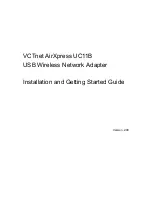
Viper SC+™ IP Router for Licensed Spectrum PN 001-5008-000 Rev. C
| Page 131
5.2.3.
USE DATA RETRIES
Increase Data Retries in the Viper Web Interface in the RF Network Settings » RF Bandwidth Management tab.
When data retries are enabled, the receiving Viper will reply with a very short RF Acknowledge message each time a
unicast data packet is received correctly. The RF Acknowledge allows the transmitting Viper to verify that the packet
was received successfully. This does, however, add a small amount of latency to each packet, reducing overall
throughput. If the transmitting Viper does not receive an RF Acknowledge, it will retransmit the message again, up to
the maximum number of data retries specified.
5.2.4.
USE COLLISION AVOIDANCE
Enable Collision Avoidance in the Viper Web Interface in the RF Network Settings » RF Bandwidth Management tab.
When enabled, the Collision Avoidance feature will transmit a short two-way handshake between the transmitting and
receiving Viper. This tells any adjacent Vipers that a data transmission will be taking place. Adjacent Vipers will wait
until the data transmission is complete before they try to capture the air by sending a new packet.
The two-way handshake reserves air time from the network for the packet transmission. It will, however, add a small
fixed latency to each packet. The added latency is small relative to the time it takes to transmit a large packet when the
chance of collision is greatest. However, when short packets need to be transmitted, it can sometimes take just as long
to complete the two-way handshake as it does to send the short packet.
For this reason, the collision avoidance parameter allows the user to specify the packet size threshold, above which the
two-way handshake is implemented. For example, if the Collision Avoidance is set for 128, then the Viper will complete
a two-way handshake before sending packets that are larger than 128 bytes, reducing potential congestion. The Viper
will NOT complete the two-way handshake before sending packets that are smaller than 128 bytes, improving
throughput.
















































